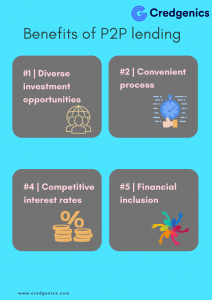Peer-to-Peer (P2P) lending, a disruptive force in the financial industry, has transformed the way individuals and small businesses access capital. It has emerged as a dynamic alternative to the traditional banking credit model. This innovative approach connects individuals looking to borrow money directly with those willing to lend, bypassing conventional intermediaries like banks and non-banking finance companies.
P2P lending platforms leverage technology to facilitate seamless interactions between borrowers and lenders. The benefits of P2P lending are many, such as ease of access, lower overhead costs, competitive interest rates, and a streamlined application process. As a result, P2P lending has gained popularity as an accessible and efficient means of obtaining financing, fostering a community-driven approach to financial transactions. Despite the potentially attractive prospect of large returns, borrowers should carefully consider the risks and benefits of peer to peer lending before participating.
What is P2P lending?
Peer-to-peer (P2P) lending is a modern financial approach that connects borrowers directly with lenders. At its core, P2P lending is an innovative financial model that leverages technology to create a marketplace where individuals and businesses can borrow and lend money without the intervention of conventional financial institutions. This innovative system operates primarily through online platforms, acting as digital bridges between those seeking funds and those willing to provide them. These platforms use sophisticated algorithms to assess risk, set interest rates, and facilitate transactions. By cutting out the middleman, P2P lending is revolutionizing how we borrow and lend money.
The benefits of peer-to-peer lending
1) Diversified credit needs
From the borrower’s standpoint, one of the major benefits of P2P lending is that the platforms offer a wide variety of loan options, ranging from personal to large business loans, covering different risk levels. This variety enables lenders to create a diversified portfolio. Borrowers benefit from the flexibility to select loans that align with their specific financial goals and risk tolerance. Whether someone is looking for safer options like personal loans or aiming for higher returns with business loans, P2P lending presents a comprehensive range of borrowing opportunities to suit individual preferences.
2) Quick and convenient process
P2P lending platforms utilize technology to simplify the borrowing process. Applicants can submit their applications online, swiftly receive loan offers, and often gain access to funds more rapidly compared to traditional lending institutions. This swift and convenient process renders P2P lending an appealing choice for individuals seeking prompt financial assistance.
3) Competitive interest rates
P2P lending platforms function with reduced overhead costs in comparison to traditional financial institutions. Consequently, borrowers can enjoy competitive interest rates. The direct link between lenders and borrowers in P2P lending can eliminate certain fees and administrative costs commonly found in traditional lending, leading to lower interest rates for borrowers.
4) Empowering borrowers and fostering financial inclusion
P2P lending facilitates financial inclusion by connecting borrowers who may have limited access to traditional loans with willing investors. This democratization of lending empowers individuals and small businesses. Consider the case of a small business owner operating in a rural area with limited access to traditional banking services. He requires capital to expand his business but faces challenges in obtaining a loan from traditional financial institutions due to stringent eligibility criteria and a lack of collateral.
In this scenario, P2P lending platforms serve as a game-changer. The business owner can create a funding request on a P2P platform, outlining his business plan, capital requirements, and expected returns. This information is then made available to a pool of potential investors on the platform. Investors, such as individuals or institutional lenders, review the proposal and assess the potential risks and rewards. Unlike traditional banks, P2P platforms often consider alternative data points and use advanced algorithms to evaluate the creditworthiness of borrowers. This makes it possible for a lender from another region of the nation, who might not have otherwise had the chance to directly assist a small business in a rural area, to decide to invest in the enterprise. The P2P lending platform facilitates this direct connection, creating a bridge between investors seeking opportunities and borrowers in need of funds.
This democratization of lending not only provides businesses with access to the capital they need but also allows investors to diversify their portfolios by supporting a range of borrowers with varying risk profiles. It exemplifies how P2P lending goes beyond traditional banking constraints, empowering both borrowers and investors in the process.
Recommended Read: Small Business Lending: Fintech Solutions for SMEs
Risks in the P2P lending landscape
1) Default risk
This is the risk that borrowers may fail to repay their loans. Factors such as economic downturns, job loss, or unforeseen personal circumstances can contribute to defaults. A significant majority of P2P loans consist of unsecured loans, implying a lack of collateral backing. Specifically, these loans predominantly fall into the category of personal loans. In the unfortunate event of a borrower default, particularly in the early stages of the loan term, it translates to a complete loss of investment.
- Impact: Lenders may experience financial losses if one or more borrowers default on their loans.
- Mitigation: Diversifying investments across multiple loans can help spread the risk and minimize the impact of individual defaults.
2) Platform risk
P2P lending platforms act as intermediaries, and there is a risk that the platform itself may face financial instability, fraudulent activities, or operational issues.
- Impact: If the platform encounters problems, it could disrupt the entire lending process, affecting repayments and potentially causing financial losses for lenders
- Mitigation: Choosing platforms with a strong reputation, transparent operations, and effective risk management practices is crucial. Regularly monitoring the platform’s financial health is also advisable
3) Regulatory and legal risks
P2P lending is subject to regulatory oversight, and changes in regulations or legal challenges can impact the industry.
- Impact: Regulatory changes or legal issues can affect the platform’s operations, leading to uncertainties for both borrowers and lenders.
- Mitigation: Staying informed about regulatory developments, choosing platforms that adhere to regulations, and understanding the legal landscape can help manage this risk.
4) Market and economic risks
P2P lending is sensitive to economic conditions. Economic downturns can affect borrowers’ ability to repay loans.
- Impact: During economic downturns, default rates may increase, impacting the overall return on investment.
- Mitigation: Lenders can consider economic indicators, diversify their investments, and carefully select loans with varying risk profiles based on economic conditions.
5) Liquidity risk
P2P loans typically have a fixed term, and it may be challenging to sell or exit investments before the term ends.
- Impact: Investors may face difficulties accessing their funds in case of unexpected financial needs.
- Mitigation: Understanding the liquidity terms of the P2P platform, opting for loans with shorter terms, or only investing what can be held until maturity can help mitigate liquidity risks.
6) Credit risk assessment
P2P platforms assess the creditworthiness of borrowers, and the accuracy of these assessments can vary.
- Impact: Incorrect credit assessments may lead to higher default rates than anticipated.
- Mitigation: Lenders can conduct independent research on borrowers, understand the platform’s credit assessment methods, and stay informed about any changes in risk evaluation practices.
Recommended Read: Instant Loans: The Rise of Real-Time Lending Solutions
Watch this video by Mint to learn about P2P lending, how it works, and the risks involved.
In Conclusion
Peer-to-peer lending presents a compelling opportunity for both lenders and borrowers. Navigating this terrain requires a delicate balance of optimism and caution. Success in P2P lending hinges on adopting a well-informed approach, coupled with robust risk management strategies. By carefully weighing the risks against the potential rewards and staying abreast of market trends and regulatory developments, stakeholders can position themselves to harness the true potential of this innovative lending model.
FAQs:
1. What are the potential benefits of P2P lending?
P2P lending provides borrowers with access to diverse loan options, fostering financial flexibility. It allows for a direct connection between borrowers and lenders, potentially resulting in more favorable loan terms compared to traditional lending sources.
2. What risks are associated with P2P lending?
P2P lending comes with inherent risks, including the possibility of borrower defaults. The unsecured nature of P2P loans means there is no collateral for recovery in case of default. Economic downturns, market volatility, and platform-related risks are also factors to consider.
3. How can participants mitigate risks in P2P lending?
Participants in P2P lending can mitigate risks by diversifying loan exposure across various platforms and loan types. Conducting thorough due diligence on P2P platforms, understanding the credit assessment process, and staying informed about market conditions and regulatory changes are crucial risk management strategies.
4. Can P2P lending contribute to financial inclusion?
Absolutely. P2P lending facilitates financial inclusion by connecting borrowers with limited access to traditional loans to a broad pool of lenders. This inclusive lending model empowers individuals and small businesses, promoting economic participation and broadening access to financial services.







